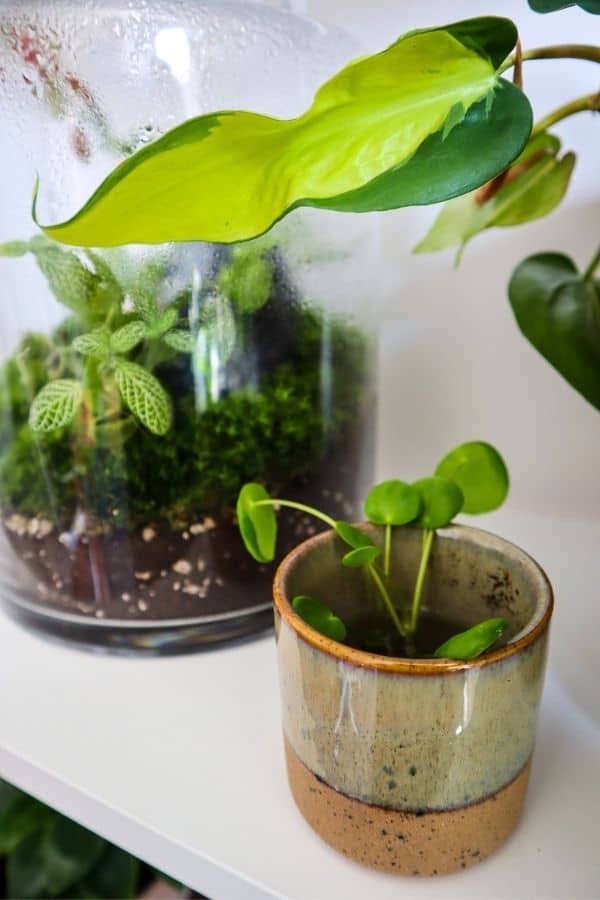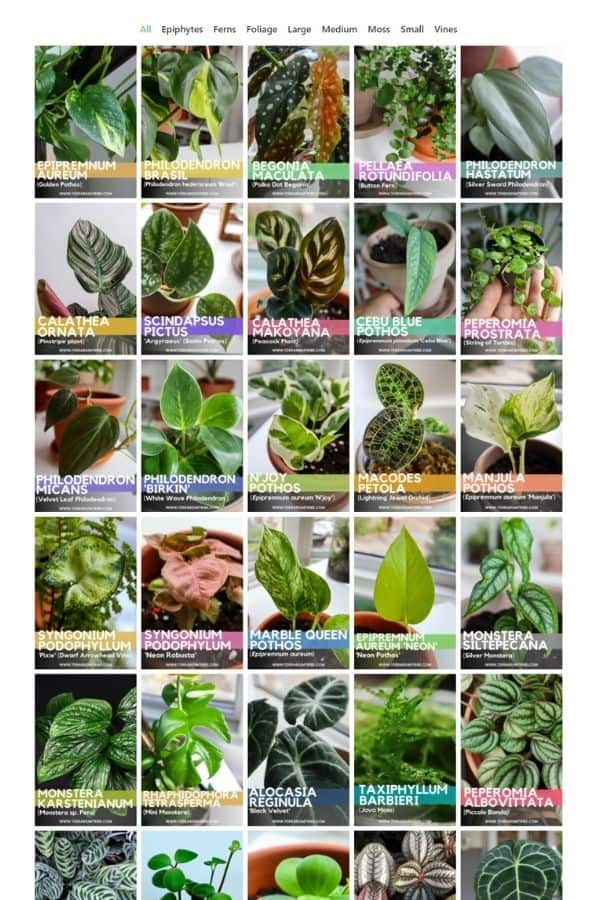There really is a lot to consider when judging if a plant is a good fit for a terrarium.
Whether it’s the plant’s shape, spread, max height, leaf diameter, zodiac sign, or daily tendency to tantrum… every plant is going to play out differently.
“Will it fit?” is probably the first thought, followed closely by “Will it grow?”, “Will it look good?” and essentially, “Wait, what is it again?”
I mean, plants obviously come in all shapes and sizes, but what they come in isn’t necessarily what they grow into.
You’d be surprised how many cute little plants can turn into absolute monsters!
So, in this guide, I’m going to walk you through all the things you need to consider, and my philosophy on what makes a “terrarium plant.”
Let’s dive in.

Terrarium Tribe is reader-supported. When you purchase through links on our site, we may earn an affiliate commission (at no further cost to you). 💜
What is a Terrarium Plant?
Firstly, even the definition of the word “terrarium” is a little vague, so unsurprisingly, we’re left to decide for ourselves what constitutes a terrarium plant.
Most people come to the conclusion that it’s a plant that is:
- Small.
- Slow-growing.
- Likes humidity.
In many ways, I’d agree with these points. It certainly fits the bill for most kinds of bottle gardens, terrariums in jars, and the like.
However, that raises two questions:
- What about larger terrariums?
- What about people who are happy to trim their plants?
That kind of just leaves small, slow-growing, likes humidity?
In reality, most tropical plants will outgrow a terrarium eventually, or at least need trimming back for the health of the ecosystem.
So, the notion of the “right” plant sizes for terrariums is super variable depending on your project and your approach.

If we limited ourselves to just the truly tiny, slow-growing, humidity-loving plants, then we’d be using the same handful of plants over and over again…
We can do better.
My Philosophy on Terrarium Plants
I prefer to empower people to make their own decisions on their plant projects.
As botanist James Wong says, “There are no mistakes in horticulture, only experiments.”
The truth is, most tropical plants will thrive in a closed terrarium (let’s not even get on to the topic of open terrariums) so for me they’re pretty much all up for debate.
It’s not about picking the “best” plants for terrariums but rather figuring out how to make any of them work.
*That being said, I know not everyone is here to test the boundaries of plant care, and some people want the easy choices. So, I do like to make it abundantly clear which ones are challenging (whether it be their size or care) and which are straightforward.
When it comes to what I consider terrarium plants, my only caveats are:
1. Plants with enormous leaf sizes.
Plants that can potentially grow bigger stems or vines can always be cut back (e.g., the different types of Pothos), but if the leaf itself is bigger than any reasonable terrarium, then there’s not much you can do about it.
For me, I think the max I’ll go to is the Anthurium clarinervium, as I have seen it in terrariums (like this beauty on Instagram), but I appreciate it’s a real challenge to do so.
Something like a Monstera deliciosa is realistically never going to happen.
2. Succulents and Cacti
There are some semi-succulent plants that do surprisingly well in terrariums (e.g., Peperomia prostrata), but generally speaking, I don’t qualify succulents or cacti as terrarium plants.
Anything that doesn’t like humidity is not a terrarium plant in my books, and there’s not really a way around that in a classic terrarium (save for venting it for 99% of the day).
Also, I just don’t like them… not sorry.
Judging Plant Sizes and Choosing Accordingly
What determines a plant’s “size”?
- The size of its leaves?
- The length or height of its stem?
- The likely maximum size or the potential max size under perfect conditions?
- The spread or density of the foliage?
Realistically, a single classification system can’t communicate all that variability.
However, I want the Terrarium Plant Index to be as helpful as possible – so I’ve created a loose system that can indicate the likely size range at maturity.
This includes the plant height/length (or arguably spread), whatever’s most relevant and largest.
- Small: 1-5 inches – Dwarf ferns, jewel orchids, mosses, bromeliads.
- Medium: 5-12 inches – Realistically, the maximum size of most tabletop terrariums.
- Large: 12 inches+ – Lots of big tropical ferns, vines, and some larger foliage plants.
Just bear in mind that this size metric can vary quite a bit as plants grown under different conditions will grow… differently. That’s also why many plants are in two size classifications, as they can be easily kept small or allowed to grow.
Even large plants can be used in small terrariums if you’re happy to trim regularly!
Plus, when it comes to ferns, for example. I almost always divide them into much smaller plants (ideally with just one or two fronds each). So, just because a fern can get big doesn’t mean it can’t easily be used in a small terrarium with the right approach.
Honestly, the list of plants for closed terrariums is huge once you know how to work with the different types.
Using the Terrarium Plant Index
We’ve designed the Terrarium Plant Index to be as expansive as possible.
Offering a wide variety of plants for projects of all shapes, sizes and biomes.

You can filter for small, medium, and large plants – along with their type, e.g., fern, foliage, epiphyte, or vine (currently, you can only apply one filter at a time, but we’re working on more).
In terms of the Plant Profiles themselves, they’re a complete overview to the plant – both in a terrarium and out. There’s so much crossover we believe it’s better to provide maximum value.
We also strive to own and grow every plant.
Growing these plants in a pot, propagating them, and then growing the new plants in a terrarium is the ideal flow for us. That way, we can speak to every step of the process.
Whilst that’s not always possible (we live in a two-bedroom apartment, and some plants are really expensive, you know), we will do as much research and collaborations as necessary to get the content right.
Over to You
How do you define a “terrarium plant”? I’d genuinely love to hear your thoughts.
Or better still, what is a terrarium to you? That seems to get more complicated by the day.
Also, if you have any feedback on how to make the Terrarium Plant Index even better – please leave me a comment below.
